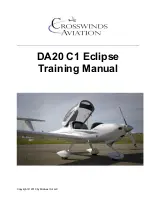
20
movement. Once you have released the B-risers, ARGOS shall, in principle,
resume fl ight immediately. An error adjustment or control or special
meteorological conditions may lead to a prolonged phase of parachuting.
The recovery of the paraglider could be then initiated by using the speed
bar. In case there is no speed bar, a short pull at the A risers (4 – 5 cm) will
achieve the same result.
Caution:
unlike the big ears and the spiral (see above), in a B-line stall the
glider is in a stalled state. Therefore, a B-line stall should never be performed
close to the ground.
6) Performance & Use of Brakes
ARGOS best glide is at a trim speed (no brakes) – about 39 km/h. The
minimum sink rate is achieved by applying approx. 15% of the brakes.
When using more than 30% of the brakes the aerodynamics and the
performance of the glider are likely to deteriorate and the effort to maneuver
will increase quickly.
In case of extremely high brake pressure there is a great risk of an impending
stall, which occurs at a full brake travel (100% of the brakes). In normal fl ying
conditions the optimal position for the brakes, in terms of performance and
safety is within the fi rst 30% of the braking range.
7) Use of Speed Bar
ARGOS is equipped with a speed system. For fi tting and positioning the
speed bar consult the instructions of the harness manufacturer. Before
every take-off check that the speed bar works freely and that its lines are
long enough to ensure that it is not engaged permanently. If the harness is
fi tted with a front mounted reserve the speed bar lines must pass under the
reserve container and the reserve bridle so that it can be deployed easily.
Using the speed bar can increase the maximum speed of the paraglider by
up to 30% of the trim speed. However, it does reduce the angle of attack and
therefore there is a risk of a frontal (or asymmetric) collapse. We therefore do
not advise to use the speed bar near the ground or in turbulent air.
8) Asymmetric or Frontal (Symmetric)
Collapses
Despite the tests proved that ARGOS recovers on its own after collapses,
active piloting is recommended in case of an asymmetric or frontal collapse.
Active piloting will reduce the loss of altitude and a change of direction.
In case of a frontal (symmetric) collapse:
Bring both brakes down symmetrically to speed up the reopening of the
paraglider, and then raise your hands back up immediately.
In case of an asymmetric collapse:
Keep the paraglider fl ying straight by leaning in the opposite direction of
the collapse and simultaneously applying the brake on the opposite side
of the collapse.
Speed up the reopening of the closed side by a single, positive input on
the collapsed side.
10) Full Stall
Certain behaviour or weather conditions can bring about a full stall. This is a
serious incident that can be diffi cult to manage. In the case where the stall
occurs at less than 100 m above the ground, it is recommended to use your
parachute.
Main Causes of a Full Stall:
A poorly timed or an extensive use of brakes when the air speed of the
wing is reduced (e. g. when coming out of a spiral or speeding up after
a B-line stall).
Soaked or heavily drenched leading edge (from rain or a cloud) can
20
Summary of Contents for ARGOS L
Page 2: ...2 CZ EN DE FR 2 ...
Page 4: ...4 4 ARGOS CZ EN DE FR 2014 Obsah Strana 5 Content Page 14 Inhalt Seite 23 Index Page 32 4 ...
Page 7: ...7 2 Schéma vyvázání ARGOS M ARGOS L 7 ...
Page 8: ...8 ARGOS S M ARGOS M L ARGOS L LX 8 ...
Page 16: ...16 2 Line plan ARGOS M ARGOS L 16 ...
Page 17: ...17 ARGOS S M ARGOS M L ARGOS L LX 17 ...
Page 25: ...25 2 Leinenschema ARGOS M ARGOS L 25 ...
Page 26: ...26 ARGOS S M ARGOS M L ARGOS L LX 26 ...
Page 34: ...34 2 Plan de suspentage ARGOS M ARGOS L 34 ...
Page 35: ...35 ARGOS S M ARGOS M L ARGOS L LX 35 ...
Page 41: ...41 41 ...
Page 47: ...47 ...
Page 49: ... 2014 Sky Paragliders a s ...











































